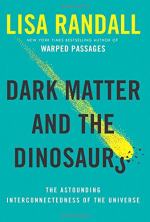|
This section contains 547 words (approx. 2 pages at 400 words per page) |

|
Dark Matter and the Dinosaurs Summary & Study Guide Description
Dark Matter and the Dinosaurs Summary & Study Guide includes comprehensive information and analysis to help you understand the book. This study guide contains the following sections:
This detailed literature summary also contains Topics for Discussion on Dark Matter and the Dinosaurs by Lisa Randall.
Value of Sharing Information
Frequently, Lisa Randall mentions her friendships, professional connections, and collaborator, as well as conferences and seminars with other physicists, astronomers, and geologists. The reader often finds her burning the midnight oil with graduate student Matthew Reece as they discuss the nature of dark matter and possible avenues for research. Randall frequently refers to the work of other scientists that is presented in professional journals and through personal contact. Physicists are not shy about expressing their opinions of current theories. Usually, the scientists welcome the different views because they realize the value of sharing their work.
Challenging Old Ideas
Sometimes, even scientists who are supposed to maintain "broad and open minds," as Lisa Randall describes it, have favorite ideas and notions to which they are attached. The history of science is nothing if not a testament to the meaningful exchange of ideas made possible through a friendly and collaborative spirit. New ideas are often resisted, or even fought. Some of these include the notion that earth is flat, or that the sun revolves around the earth, or that humans evolved from ape-like ancestors. In modern times, scientists have come to use the standard of whether a new idea or theory is "elegant" to determine its value in an intuitive fashion.
Exploring the Unknown
Physics, by ts very nature, can often seem chimerical, elusive, and strange for the simple reason that it is not always possible to design experiments to test new ideas. In many instances, theories and intuitions precede scientific proof. Occam's Razor and the notion of elegance have proven to be useful guidelines for intellectual exercises in physics and other sciences. Lisa Randall shows that the Hadron Super-Collider in Switzerland, space satellites, and even balloon excursions into the upper atmosphere have proven to be very useful tools for astrophysicists to push ahead their ideas and theories. It is finding answers for the many unknowns that drives scientists. Curiously, it is also imaginative curiosity that drives the works of many science fiction writers.
Working with Half-baked Ideas
In order to find the truth, sometimes a scientist must follow an idea that turns out to be wrong in the face of accumulating scientific evidence. As Randall's book demonstrates, scientists often learn more from their mistakes than from their triumphs. For this reason, she says, it is important to pursue interesting theories, even if they do not fly in the face of reality. Oftentimes there is a core of truth hidden beneath layers of misguided thinking that will emerge when the gem of original thought is cleaned and buffed.
Maintaining an Open Mind
Lisa Randall's book underscores the necessity of maintaining an open mind in theoretical physics—as in many other areas of intellectual pursuit. Surely there was more than the king's gold that drove Christoper Columbus toward the Americas. If Columbus had a completely closed mind, he probably would never have taken his journey because of the danger of falling off the edge of the earth. If the Wright Brothers had truly believed that powered human flight was impossible, why would they have toiled to build their airplane? If the dark matter deniers hold onto their belief, they will undoubtedly be left behind in the forward march of astrophysics, as Randall's book makes clear.
Read more from the Study Guide
|
This section contains 547 words (approx. 2 pages at 400 words per page) |

|




